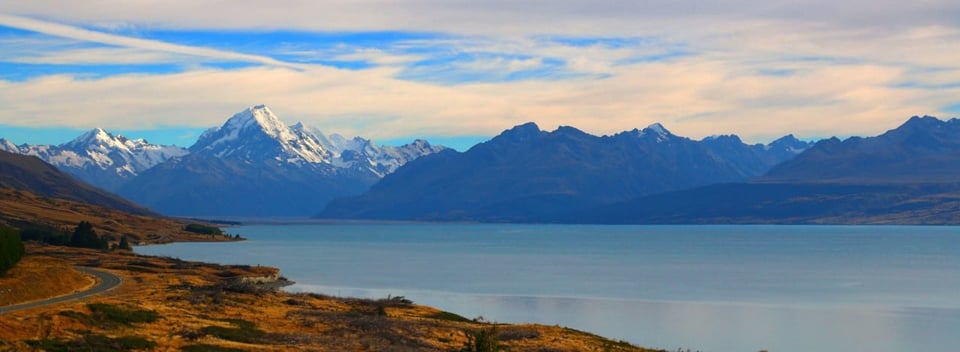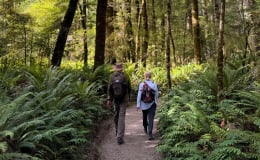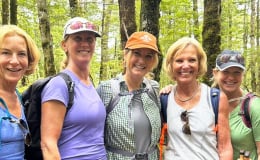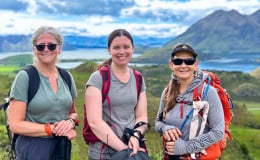
Exploring New Zealand's World Heritage Sites
The words ‘World Heritage’ are synonymous with places of incredible natural beauty. Chosen for their outstanding universal value, they never fail to stir up emotions in those who venture to experience them.
The south-west of New Zealand is a designated World Heritage site. It takes up a massive 10% of New Zealand’s total land area, that is a whopping 2.6 million hectares (6.4 million acres). This encompasses Westland, Aoraki/Mount Cook, Fiordland and Mount Aspiring National Parks.

The views from the Sealy Tarns Track in Aoraki/Mt Cook National Park are stunning!
The landscape has been shaped by successive glaciations into sheer fjords, rocky coastlines, lakes, waterfalls and towering cliffs. Two-thirds of the site is covered with podocarps and southern beech trees - some of which are over 800 years old. The Kea, the world’s only alpine parrot, lives in the park, as does the very rare and endangered flightless bird, the Takahe.
A World Heritage Trail
We want to share these great wilderness areas with you. Through hard work and reputation, we have secured the highly prized concessions granted only by the Department of Conservation, allowing us to guide guests into this World Heritage site of outstanding natural value.
In homage to the area, we named our original walking tour our World Heritage tour. On this 13-day tour, we set out to explore the symmetries of life above and below the ground, where water cascades from mountain peaks and rainforest, from roaring untamed coastlines, into the black depths of ice-age carved valleys and deep underground glow-worm habitats. Found in the wild are the native species of New Zealand including kea, mohua, kotuku, fur seals, bottlenose dolphins and, if we are very lucky, the very rare Fiordland crested penguin that nests in the remote Martins Bay. On our journey, we'll take you around the four great national parks that form the backbone of this World Heritage Site.
Fiordland National Park

Beautiful Fiordland.
This is the largest of the 14 national parks in New Zealand and has spectacular fiords carved by rivers of ice, hanging valleys, pristine lakes, valleys, rugged ridge-lines and lush native beech forest stretching from mountains to the southern ocean. New Zealand Trails explores four unique parts of this park. The exquisite Milford Sound is experienced by air, land and ocean - hiking, boating and via helicopter we enhance your experience to the max. The impact of the glorious isolation of both Martins Bay and the Hollyford Valley, home to some of Fiordland's most ancient trees and rare wildlife, steeped in both Maori and colonial history, will linger with you for a lifetime.
Aoraki / Mount Cook National Park

The Hooker Valley Track is one of the must-do walks in Mount Cook.
Aoraki/Mount Cook National Park is a rugged fantasyland of ice and rock, with 19 peaks over 3,000 metres (9800 feet) including New Zealand's highest mountain. The park is known for its rugged alpine beauty and contrasting delicate alpine flower - the Mount Cook Lily. Its Maori name, ‘Aoraki’ means ‘Cloud Piercer’ and at 12,016ft (3,754m) it towers above the surrounding snow-covered peaks providing an inspiring backdrop as we hike the Hooker Valley. For those that have a little more vim than most, it's up to the Sealy Tarns for a more challenging option with a steep climb around 550 vertical metres (1800 feet) – the reward being a stunning panorama of New Zealand’s highest peaks.
Mount Aspiring National Park

Enjoy the peace and tranquillity of Mou Waho Island.
Mount Aspiring National Park is located in the Southern Alps, a wonderful mixture of remote wilderness, high mountains and beautiful river valleys. Here you'll hike the eastern end (the Glenorchy side) of the Routeburn Track. Hiking along the river flats and up to the spectacular Routeburn Falls – this a contender for the best day walk in New Zealand.
Lying close to the centre of Lake Wanaka is Mou Waho Island Nature Reserve. A unique glacial remnant of the last ice age, the island is also the historic site of early shipbuilding. After a lake cruise, we take a well-formed track through native bush to near the top of the Tyrwhitt Peak. Here we see Arethusa Pool, a small lake on the island with a small island within it, and on that island is another even smaller lake - very intriguing indeed! From the top of the island, we have a stunning 360-degree view of Lake Wanaka and its surrounding mountains and valleys. Try as hard as you can and despite the uninterrupted views, it is impossible to see any form of human civilisation – incredible!
Westland National Park

The spectacular Lake Matheson.
Westland Tai Poutini National Park is located about halfway down the South Island on the Wild West Coast of New Zealand. If its contrast you want, then we have it in spades. Firstly we kayak Okarito Lagoon. This is the largest unmodified wetland in New Zealand, covering 3,000 hectares (7,400 acres) of shallow open calm water and tidal flats and is surrounded by magnificent kahikatea and rimu forest. The area is so green and luxuriant that it has been often compared to the Amazonian rainforest with many species of ferns and mosses festooning the towering trees and wild orchids throughout its forest. But more importantly, Okarito Lagoon is well known for its outstanding avifauna (over 70 species of birds have been recorded here). The lagoon is a common feeding ground for kotuku (white heron) and royal spoonbill, both of which breed in the nearby Waitangiroto Nature Reserve.
Remnants of the last ice age (10,000 years ago) cascade from the Alps vast snowfields to valley floors, just 300 metres (900 feet) above sea level. Nowhere else in the world are glaciers in the temperate zone so accessible. At nearby Franz Josef glacier we can walk right up the terminal face and at Fox Glacier we get right out on the glacier and hike a small section of the 20-kilometre (12 mile) glacier, set amidst the greenery and lushness of a temperate rainforest.
Lake Matheson (the reflection of perfection) is a wonder in its own right. The dark brown waters of the lake create the ideal reflective surface and by a beautiful coincidence, the mountains to the east are perfectly positioned to reflect on the lake creating a picture-perfect postcard reflection.
If you would like further information please take a look at our Grand Explorer or New Zealand 'World Heritage Walking Tour' or give us a call.







